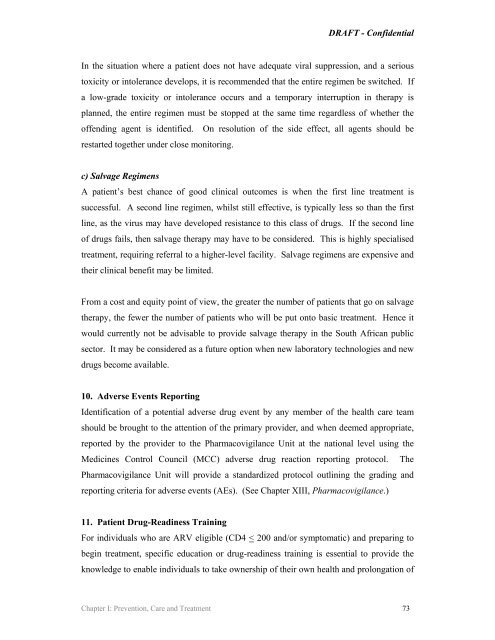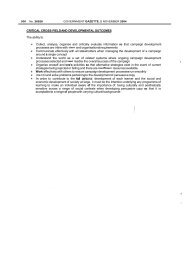Operational plan for comprehensive HIV and AIDS care and ...
Operational plan for comprehensive HIV and AIDS care and ...
Operational plan for comprehensive HIV and AIDS care and ...
Create successful ePaper yourself
Turn your PDF publications into a flip-book with our unique Google optimized e-Paper software.
DRAFT - Confidential<br />
In the situation where a patient does not have adequate viral suppression, <strong>and</strong> a serious<br />
toxicity or intolerance develops, it is recommended that the entire regimen be switched. If<br />
a low-grade toxicity or intolerance occurs <strong>and</strong> a temporary interruption in therapy is<br />
<strong>plan</strong>ned, the entire regimen must be stopped at the same time regardless of whether the<br />
offending agent is identified. On resolution of the side effect, all agents should be<br />
restarted together under close monitoring.<br />
c) Salvage Regimens<br />
A patient’s best chance of good clinical outcomes is when the first line treatment is<br />
successful. A second line regimen, whilst still effective, is typically less so than the first<br />
line, as the virus may have developed resistance to this class of drugs. If the second line<br />
of drugs fails, then salvage therapy may have to be considered. This is highly specialised<br />
treatment, requiring referral to a higher-level facility. Salvage regimens are expensive <strong>and</strong><br />
their clinical benefit may be limited.<br />
From a cost <strong>and</strong> equity point of view, the greater the number of patients that go on salvage<br />
therapy, the fewer the number of patients who will be put onto basic treatment. Hence it<br />
would currently not be advisable to provide salvage therapy in the South African public<br />
sector. It may be considered as a future option when new laboratory technologies <strong>and</strong> new<br />
drugs become available.<br />
10. Adverse Events Reporting<br />
Identification of a potential adverse drug event by any member of the health <strong>care</strong> team<br />
should be brought to the attention of the primary provider, <strong>and</strong> when deemed appropriate,<br />
reported by the provider to the Pharmacovigilance Unit at the national level using the<br />
Medicines Control Council (MCC) adverse drug reaction reporting protocol. The<br />
Pharmacovigilance Unit will provide a st<strong>and</strong>ardized protocol outlining the grading <strong>and</strong><br />
reporting criteria <strong>for</strong> adverse events (AEs). (See Chapter XIII, Pharmacovigilance.)<br />
11. Patient Drug-Readiness Training<br />
For individuals who are ARV eligible (CD4 < 200 <strong>and</strong>/or symptomatic) <strong>and</strong> preparing to<br />
begin treatment, specific education or drug-readiness training is essential to provide the<br />
knowledge to enable individuals to take ownership of their own health <strong>and</strong> prolongation of<br />
Chapter I: Prevention, Care <strong>and</strong> Treatment 73
















